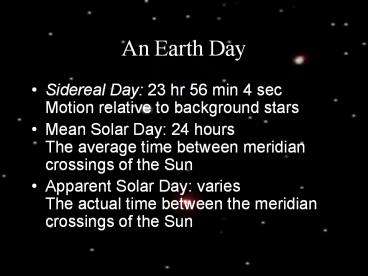An Earth Day PowerPoint PPT Presentation
Title: An Earth Day
1
An Earth Day
- Sidereal Day 23 hr 56 min 4 secMotion relative
to background stars - Mean Solar Day 24 hoursThe average time between
meridian crossings of the Sun - Apparent Solar Day variesThe actual time
between the meridian crossings of the Sun
2
Solar vs. Sidereal Day
3
Lunar Month
- Synodic month 29.53 days. Defined by the period
of the phases. - Sidereal month 27.32 days. Defined by the
motion relative to the stars. - Anomalistic month 27.55 days. Defined as time
between perigees.
4
Synodic vs. Sidereal Month
5
An Earth Year
- Julian Year 365.25 mean solar days. Used in
calendars before 1582. - Gregorian Year 365.2425 mean solar days. Used
in calendars today. - Sidereal Year 365.2564 mean solar days. Defined
by the motion relative to stars. - Tropical year 365.2422 mean solar days. Defined
from equinox to equinox. Thus, related to the
seasons.
6
Earth Orbits Sun
7
Definitions
- Zenith The point on the sky that is directly
overhead of the observer. - Horizon The great circle on the celestial sphere
that is 90 degrees from the zenith - Hour circle The great circle through the
position of a celestial body and the celestial
poles - Meridian The hour circle that passes through the
zenith and both celestial poles
8
Directions on the Local Sky
- Altitude The minimum angular distance between
the position of a celestial body and the horizon - Azimuth The angular bearing of an object,
measured from North (0 degrees) through East (90
degrees), South (180 degrees), West (270
degrees), and back to North (360 degrees) - Hour Angle The angle between the meridian and an
objects hour circle (west is positive)
9
The Celestial Sphere
10
Celestial Coordinates
- 1 hour 15 degrees
- Declination The minimum angular distance from
the position of a celestial body and the
celestial equator - Right Ascension The eastward angle from the
vernal equinox to the intersection of an objects
hour circle with the equator
11
Measuring Time
- Apparent Solar Time The actual hour angle of
the Sun 12 hours (using 24-hour clock). - Mean Solar Time The hour angle of the average
Sun 12 hours - Universal Time Mean Solar Time at Greenwich,
England - Standard Time Time assigned by time zone
12
Time Zones
13
Measuring Time
- Equation of Time the difference between the
apparent solar time and mean solar time - Local Sidereal Time Time measured by the
position of the stars. - Local Sidereal Time Right Ascension of objects
at the Merdian - Local Sidereal Time Right Ascension Hour Angle

